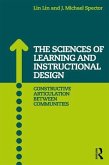Trends and Issues in Instructional Design and Technology
Herausgeber: Reiser, Robert A.; Dempsey, John V.; Carr-Chellman, Alison A.
Trends and Issues in Instructional Design and Technology
Herausgeber: Reiser, Robert A.; Dempsey, John V.; Carr-Chellman, Alison A.
- Gebundenes Buch
- Merkliste
- Auf die Merkliste
- Bewerten Bewerten
- Teilen
- Produkt teilen
- Produkterinnerung
- Produkterinnerung
Trends and Issues in Instructional Design and Technology provides current and future IDT professionals with a clear picture of current and future developments in the field that are likely to impact their careers and the organizations they work for.
Andere Kunden interessierten sich auch für
![Trends and Issues in Distance Education Trends and Issues in Distance Education]() Trends and Issues in Distance Education63,99 €
Trends and Issues in Distance Education63,99 €![Trends and Issues in Distance Education Trends and Issues in Distance Education]() Trends and Issues in Distance Education109,99 €
Trends and Issues in Distance Education109,99 €![The Instructional Design Trainer's Guide The Instructional Design Trainer's Guide]() The Instructional Design Trainer's Guide178,99 €
The Instructional Design Trainer's Guide178,99 €![Instructional Design for Organizational Justice Instructional Design for Organizational Justice]() Lisa A. GiacumoInstructional Design for Organizational Justice152,99 €
Lisa A. GiacumoInstructional Design for Organizational Justice152,99 €![The Sciences of Learning and Instructional Design The Sciences of Learning and Instructional Design]() The Sciences of Learning and Instructional Design60,99 €
The Sciences of Learning and Instructional Design60,99 €![Advanced Instructional Design Techniques Advanced Instructional Design Techniques]() Jill E. StefaniakAdvanced Instructional Design Techniques179,99 €
Jill E. StefaniakAdvanced Instructional Design Techniques179,99 €![The Sciences of Learning and Instructional Design The Sciences of Learning and Instructional Design]() The Sciences of Learning and Instructional Design199,99 €
The Sciences of Learning and Instructional Design199,99 €-
-
-
Trends and Issues in Instructional Design and Technology provides current and future IDT professionals with a clear picture of current and future developments in the field that are likely to impact their careers and the organizations they work for.
Produktdetails
- Produktdetails
- Verlag: Routledge
- 5. Auflage
- Seitenzahl: 646
- Erscheinungstermin: 6. August 2024
- Englisch
- Abmessung: 260mm x 183mm x 39mm
- Gewicht: 1391g
- ISBN-13: 9781032819761
- ISBN-10: 1032819766
- Artikelnr.: 70146258
- Herstellerkennzeichnung
- Libri GmbH
- Europaallee 1
- 36244 Bad Hersfeld
- gpsr@libri.de
- Verlag: Routledge
- 5. Auflage
- Seitenzahl: 646
- Erscheinungstermin: 6. August 2024
- Englisch
- Abmessung: 260mm x 183mm x 39mm
- Gewicht: 1391g
- ISBN-13: 9781032819761
- ISBN-10: 1032819766
- Artikelnr.: 70146258
- Herstellerkennzeichnung
- Libri GmbH
- Europaallee 1
- 36244 Bad Hersfeld
- gpsr@libri.de
Robert A. Reiser is Professor Emeritus, former Associate Dean for Research, Robert M. Morgan Professor of Instructional Systems, and Distinguished Teaching Professor in the College of Education at Florida State University, USA. Alison A. Carr-Chellman is Dean of the School of Education and Health Sciences, and Professor of Teacher Education at the University of Dayton, USA. John V. Dempsey is retired Professor and founding Director of USAonline and the Innovation in Learning Center at the University South Alabama, USA.
1. What Field Did You Say You Were In?: Defining and Naming Our Field 2. A
History of Instructional Design And Technology 3. Characteristics and
Evolution of Foundational Instructional Design Models 4. You Only Need
Three Crayons: An Instructional Design Theory 5. The Successive
Approximation Model (SAM) 6. Psychological Foundations of Instructional
Design 7. Constructivism for Active, Authentic Learning 8. The Learning
Sciences: Where They Came from and What It Means for Instructional
Designers 9. Motivation, Volition, and Performance 10. Profound Learning
for Human Flourishing 11. Systems Influence on Instructional Design and
Technology 12. Social Emotional Learning 13. Problem-Based Learning:
Essential Design Characteristics 14. Keep It Real: The Benefits of
Authentic Tasks in Contemporary Learning Environments 15. Evaluation in
Instructional Design: A Comparison of the Major Evaluation Models 16.
Measuring the Return on Investment (ROI) in Technology-Based Learning 17.
Learning Engineering 18. The Role of Human Performance Technology in
Learning Design 19. Informal Learning 20. Problems, Potential, and Promise
of Open Badges: Creating a Design Strategy 21. Instructional Design in
Business and Industry 22. Instructional Design Opportunities in Military
Education and Training Environments 23. What Should IDs Do to Advance
Health Professions Education? 24. Integrating Technology into K-12
Education 25. Instructional Designers in Higher Education 26. Stories From
the Globe: Practitioners' Voices on Instructional Design and Technology 27.
Leaving All Doors Open: Career Options for Those Studying Instructional
Design and Technology 28. Getting an Instructional Design Position:
Lessons From a Personal History 29. Avenues to Support the Professional
Development of Instructional Designers 30. Performance Consulting 31.
Hybrid Classroom Design and Implementation: Electronic Synchronous
Multi-Site (ESyMS) Learning 32. Learning with Podcasts 33. Social Media and
Instructional Design 34. Artificial Intelligence (AI) 35. Designing for
E-Learning 36. Designing Educational Videogames: Balancing Learning,
Assessment, and Fun 37. Professional Ethics: Design Practices for an
Embedded Approach 38. Diversity and Inclusion in Design for Learning and
Human Performance Technologies 39. Changing Conceptions of Design 40.
Future Research Directions for Instructional Design and Technology 41.
Epilogue
History of Instructional Design And Technology 3. Characteristics and
Evolution of Foundational Instructional Design Models 4. You Only Need
Three Crayons: An Instructional Design Theory 5. The Successive
Approximation Model (SAM) 6. Psychological Foundations of Instructional
Design 7. Constructivism for Active, Authentic Learning 8. The Learning
Sciences: Where They Came from and What It Means for Instructional
Designers 9. Motivation, Volition, and Performance 10. Profound Learning
for Human Flourishing 11. Systems Influence on Instructional Design and
Technology 12. Social Emotional Learning 13. Problem-Based Learning:
Essential Design Characteristics 14. Keep It Real: The Benefits of
Authentic Tasks in Contemporary Learning Environments 15. Evaluation in
Instructional Design: A Comparison of the Major Evaluation Models 16.
Measuring the Return on Investment (ROI) in Technology-Based Learning 17.
Learning Engineering 18. The Role of Human Performance Technology in
Learning Design 19. Informal Learning 20. Problems, Potential, and Promise
of Open Badges: Creating a Design Strategy 21. Instructional Design in
Business and Industry 22. Instructional Design Opportunities in Military
Education and Training Environments 23. What Should IDs Do to Advance
Health Professions Education? 24. Integrating Technology into K-12
Education 25. Instructional Designers in Higher Education 26. Stories From
the Globe: Practitioners' Voices on Instructional Design and Technology 27.
Leaving All Doors Open: Career Options for Those Studying Instructional
Design and Technology 28. Getting an Instructional Design Position:
Lessons From a Personal History 29. Avenues to Support the Professional
Development of Instructional Designers 30. Performance Consulting 31.
Hybrid Classroom Design and Implementation: Electronic Synchronous
Multi-Site (ESyMS) Learning 32. Learning with Podcasts 33. Social Media and
Instructional Design 34. Artificial Intelligence (AI) 35. Designing for
E-Learning 36. Designing Educational Videogames: Balancing Learning,
Assessment, and Fun 37. Professional Ethics: Design Practices for an
Embedded Approach 38. Diversity and Inclusion in Design for Learning and
Human Performance Technologies 39. Changing Conceptions of Design 40.
Future Research Directions for Instructional Design and Technology 41.
Epilogue
1. What Field Did You Say You Were In?: Defining and Naming Our Field 2. A
History of Instructional Design And Technology 3. Characteristics and
Evolution of Foundational Instructional Design Models 4. You Only Need
Three Crayons: An Instructional Design Theory 5. The Successive
Approximation Model (SAM) 6. Psychological Foundations of Instructional
Design 7. Constructivism for Active, Authentic Learning 8. The Learning
Sciences: Where They Came from and What It Means for Instructional
Designers 9. Motivation, Volition, and Performance 10. Profound Learning
for Human Flourishing 11. Systems Influence on Instructional Design and
Technology 12. Social Emotional Learning 13. Problem-Based Learning:
Essential Design Characteristics 14. Keep It Real: The Benefits of
Authentic Tasks in Contemporary Learning Environments 15. Evaluation in
Instructional Design: A Comparison of the Major Evaluation Models 16.
Measuring the Return on Investment (ROI) in Technology-Based Learning 17.
Learning Engineering 18. The Role of Human Performance Technology in
Learning Design 19. Informal Learning 20. Problems, Potential, and Promise
of Open Badges: Creating a Design Strategy 21. Instructional Design in
Business and Industry 22. Instructional Design Opportunities in Military
Education and Training Environments 23. What Should IDs Do to Advance
Health Professions Education? 24. Integrating Technology into K-12
Education 25. Instructional Designers in Higher Education 26. Stories From
the Globe: Practitioners' Voices on Instructional Design and Technology 27.
Leaving All Doors Open: Career Options for Those Studying Instructional
Design and Technology 28. Getting an Instructional Design Position:
Lessons From a Personal History 29. Avenues to Support the Professional
Development of Instructional Designers 30. Performance Consulting 31.
Hybrid Classroom Design and Implementation: Electronic Synchronous
Multi-Site (ESyMS) Learning 32. Learning with Podcasts 33. Social Media and
Instructional Design 34. Artificial Intelligence (AI) 35. Designing for
E-Learning 36. Designing Educational Videogames: Balancing Learning,
Assessment, and Fun 37. Professional Ethics: Design Practices for an
Embedded Approach 38. Diversity and Inclusion in Design for Learning and
Human Performance Technologies 39. Changing Conceptions of Design 40.
Future Research Directions for Instructional Design and Technology 41.
Epilogue
History of Instructional Design And Technology 3. Characteristics and
Evolution of Foundational Instructional Design Models 4. You Only Need
Three Crayons: An Instructional Design Theory 5. The Successive
Approximation Model (SAM) 6. Psychological Foundations of Instructional
Design 7. Constructivism for Active, Authentic Learning 8. The Learning
Sciences: Where They Came from and What It Means for Instructional
Designers 9. Motivation, Volition, and Performance 10. Profound Learning
for Human Flourishing 11. Systems Influence on Instructional Design and
Technology 12. Social Emotional Learning 13. Problem-Based Learning:
Essential Design Characteristics 14. Keep It Real: The Benefits of
Authentic Tasks in Contemporary Learning Environments 15. Evaluation in
Instructional Design: A Comparison of the Major Evaluation Models 16.
Measuring the Return on Investment (ROI) in Technology-Based Learning 17.
Learning Engineering 18. The Role of Human Performance Technology in
Learning Design 19. Informal Learning 20. Problems, Potential, and Promise
of Open Badges: Creating a Design Strategy 21. Instructional Design in
Business and Industry 22. Instructional Design Opportunities in Military
Education and Training Environments 23. What Should IDs Do to Advance
Health Professions Education? 24. Integrating Technology into K-12
Education 25. Instructional Designers in Higher Education 26. Stories From
the Globe: Practitioners' Voices on Instructional Design and Technology 27.
Leaving All Doors Open: Career Options for Those Studying Instructional
Design and Technology 28. Getting an Instructional Design Position:
Lessons From a Personal History 29. Avenues to Support the Professional
Development of Instructional Designers 30. Performance Consulting 31.
Hybrid Classroom Design and Implementation: Electronic Synchronous
Multi-Site (ESyMS) Learning 32. Learning with Podcasts 33. Social Media and
Instructional Design 34. Artificial Intelligence (AI) 35. Designing for
E-Learning 36. Designing Educational Videogames: Balancing Learning,
Assessment, and Fun 37. Professional Ethics: Design Practices for an
Embedded Approach 38. Diversity and Inclusion in Design for Learning and
Human Performance Technologies 39. Changing Conceptions of Design 40.
Future Research Directions for Instructional Design and Technology 41.
Epilogue









